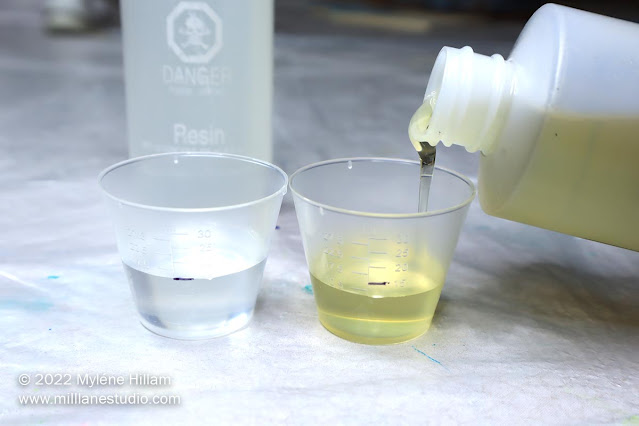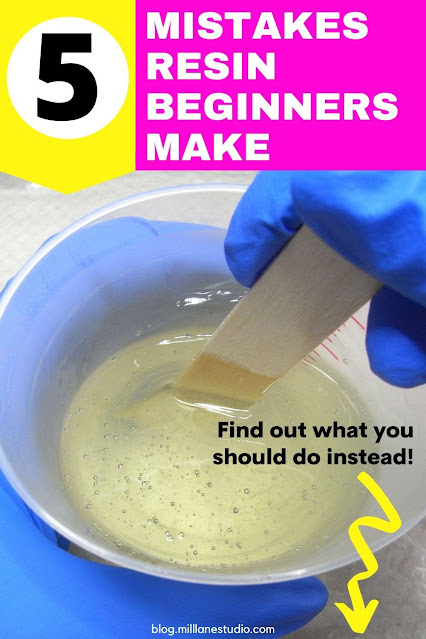When you first start out with resin, you're bound to make rookie mistakes.
Resin is more TECHNICAL than most crafts you've tried and there's a lot to learn, so don't be too hard on yourself... everyone was a beginner once - even the experts!
There's a whole lot more to working with resin successfully than just mixing the resin and hardener together and pouring it. And it's often the basic things that trip beginners up.
Here are 5 common mistakes I see beginners make all the time. The good news is that if you pay attention to these, you're much more likely to be successful with resin.
1. Not Reading the Instructions
Now that you've discovered resin and the incredible things you can make with it, you're keen to create your first resin project. The prospect of making really cool things is exciting and you're anxious to get started!So, you've got your resin, some moulds (or a surface to pour the resin on), you have colours, glitters, and powders. Now you just want to dive in and make something amazing, right?
WRONG!!
Diving in without learning about the resin you've chosen is a recipe for failure.
You need to know the characteristics of the resin you've chosen. Each resin is different... it will have different requirements and different peculiarities.
You need to know things like...
... whether to measure by volume or by weight
... the pot life (a fancy term for how long you can work with it before it's too thick and sticky)
... the curing time (how long before you can handle it)
... the temperature it likes
... and many other things that will make the resin cure properly.
You'll find all this important information in the instructions, so it's essential that you read them before you start measuring resin. Even if you're experienced with resin, you should still READ THE INSTRUCTIONS.
Hint: if your resin kit doesn't come with this information, contact the manufacturer for instructions, or switch to a brand that supplies more complete instructions, like Alumilite Amazing Clear Cast, Art Resin. or Easy Cast. These are all great beginner resins.
2. Not Measuring Accurately
For the chemical reaction to happen that makes resin cure, you must measure accurately... you can't just eyeball it!- If the instructions say measure by volume, use measuring cups with graduated measurements.
- For resins that are measured by weight, use a digital scale with 1 gram increments. This is the scale I use. It's compact, easy to read and accurate!
- Check the ratio of resin to hardener for your resin. That could be 1:1, 2:1, 3:1 or some other ratio. Always make sure you use the correct ratio for your resin kit. If you use the wrong ratio, your resin won't cure properly.
- If you're thinking of adding more hardener, DON'T!
... It won't make the resin cure harder
... It won't cure faster
... It will just be a sticky mess
3. Not Mixing the Resin Well Enough
If your resin is soft when it's cured, or you get a few sticky spots on the surface, this is the result of resin that hasn't been mixed thoroughly.But what does mixing the resin THOROUGHLY mean?
Is it enough to mix the resin for as long as the instructions in your resin kit say? Mixing it for 2 or 3 minutes seems like a lot of stirring, right? And after that long, your hand starts to feel like it's going to fall off!
There's more to getting the resin properly blended than just mixing it for the required time.
If you still see syrupy-looking strings in the resin (even tiny ones), then you need to keep mixing. If they remain in the resin, they can end up on the surface of your resin and cause sticky spots that will never cure.
When you're mixing the resin, the things you need to look out for are:
- blending the two parts together for at least as long as the instructions say
- scraping the unmixed resin from the walls and bottom of your cup (do it more than once!)
- and most importantly, mixing until there are no striations left in the resin.
4. Stirring the Resin Too Fast.
Stirring the resin fast might get the job done quickly but it also introduces 1000s of bubbles!
There's no need to whip the resin to blend it thoroughly. After all, you're mixing resin, not beating cake batter!
Slow and steady wins the race.
If it takes longer than the suggested amount of time to mix the epoxy, that's OK... you usually have 30-45 minutes before the epoxy resin gets too thick to work with, so if it takes 4 or 5 minutes of gentle stirring so that you minimise bubbles, then it's 4 or 5 minutes well spent...
Imagine not having to deal with bubbles in your resin!
If it takes longer than the suggested amount of time to mix the epoxy, that's OK... you usually have 30-45 minutes before the epoxy resin gets too thick to work with, so if it takes 4 or 5 minutes of gentle stirring so that you minimise bubbles, then it's 4 or 5 minutes well spent...
Imagine not having to deal with bubbles in your resin!
5. Starting with a project that is too large or too ambitious
Many newcomers to resin get excited about the prospect of doing a grand project.Starting on a project that is important to you, such as a memorial piece, embedding your wedding flowers in resin or a large resin painting is not a good idea.
People who do this type of resin work make it look so easy because they have a LOT of experience and understand how to work with resin.
To be successful with larger projects, you first need to be successful with smaller projects and understand the quirks of how resin works.
To be successful with larger projects, you first need to be successful with smaller projects and understand the quirks of how resin works.
Instead, start small, gain confidence, improve your skills, and learn how your resin behaves before you move on to a large project... because failed projects are discouraging and leave you OUT OF POCKET.
We all have to walk before we can run. And nothing could be more true when working with resin.
Resin has many nuances and takes some getting used to, so...
... learn the basics
... follow the instructions
... and don't overestimate your abilities.
Now that you know the common mistakes beginners make, you can look out for them... and you'll be much more likely to have a ton of fun and success with resin.
PIN THESE RESIN TIPS!
Happy Resining!

Subscribe to my email list and learn how to resin like an expert.








